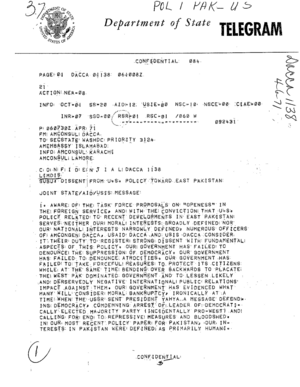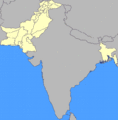Indo-Pakistani War of 1971 facts for kids
Quick facts for kids Indo-Pakistani War of 1971 |
|||||||||
|---|---|---|---|---|---|---|---|---|---|
| Part of the Indo-Pakistani wars and conflicts and Bangladesh Liberation War | |||||||||
 First Row: Lt-Gen. A.A.K. Niazi, the Cdr. of Pakistani Eastern Comnd., signing the documented instrument in Dacca in the presence of Lt. Gen. Jagjit Singh Aurora (GOC-in-C of Indian Eastern Comnd.). Surojit Sen of All India Radio is seen holding a microphone on the right. Second Row (left to right): Vice Adm. N. Krishnan (FOC-in-C Eastern Naval Comnd.), Air Mshl. H.C. Dewan, (AOC-in-C Eastern Air Comnd., Lt Gen. Sagat Singh (Cdr. IV Corps), Maj Gen. JFR Jacob (COS Eastern Comnd.) and Flt Lt Krishnamurthy (peering over Jacob‘s shoulder). |
|||||||||
|
|||||||||
| Belligerents | |||||||||
|
|
East Pakistan |
||||||||
| Commanders and leaders | |||||||||
(Prime Minister of India) (President of India) (External Minister of India) (Defence Minister of India) (Chief of Army Staff) (GOC-in-C, Eastern Command) (GOC-in-C, Southern Command) (GOC-in-C, Western Command) (GOC-in-C, Central Command) (GOC-in-C, IV Corps) (GOC-in-C, II Corps) (GOC-in-C, XV Corps) (GOC-in-C, I Corps) (COS, Eastern Command) (COS, IV Corps) (Dir, Military Operations) (Chief of Naval Staff) (Cdr. Western Naval Command) (Cdr. Eastern Naval Command) (Cdr. Eastern Fleet) (Chief of Air Staff) (Director of RAW) (PM Provisional Government) (Commander, Mukti Bahini) |
(President of Pakistan) (Prime Minister of Pakistan) (Chief of Staff, Army GHQ) (Commander, Eastern Command) (Chief of General Staff) (Commander, I Corps) (Commander, II Corps) (Commander, IV Corps) (GOC, 23rd Infantry Division) (GOC, 14th Infantry Division) (Cdr-in-Chief, Navy) (COS, Navy NHQ) (Cdr, Eastern Naval Command) (Cdr, Western Naval Command) (Commander, Pakistan Marines) (Cdr-in-Chief, Air Force) (Chief Ins, Pakistan Air Force) (Cdr Eastern Air Command) (COS, Air AHQ Dhaka) Abdul Motaleb Malik (Governor of East Pakistan) |
||||||||
| Strength | |||||||||
| Indian Armed Forces: 1,000,000 Mukti Bahini: 180,000 Total: 1,180,000 |
Pakistan Armed Forces: 350,000 | ||||||||
| Casualties and losses | |||||||||
|
Pakistani claims
Indian claims
Neutral claims
|
Pakistani claims
Indian claims
Neutral claims
|
||||||||
The Indo-Pakistani War of 1971 was a short but important war between India and Pakistan. It lasted only 13 days, from December 3 to December 16, 1971. This makes it one of the shortest wars in modern history.
During the war, soldiers from India and Pakistan fought on two main fronts: the eastern side and the western side. The war ended when the Pakistani military in East Pakistan signed a document called the Instrument of Surrender (1971) on December 16, 1971. After this, East Pakistan became an independent country named Bangladesh. About 93,000 Pakistani soldiers and civilians were taken as prisoners of war by India.
Contents
International Involvement in the War
Many countries had different views on the war. Some supported India and Bangladesh, while others supported Pakistan.
The Soviet Union's Role
The Soviet Union (now Russia) supported Bangladesh and India. They helped the Indian Army and the Mukti Bahini, who were freedom fighters from Bangladesh. The Soviets believed that an independent Bangladesh would weaken the power of their rivals, the United States and China. The Soviet Union also had a friendship treaty with India, promising support if needed.
The United States' Role
The United States supported Pakistan with political backing and supplies. US leaders like President Richard Nixon and his Secretary of State Henry Kissinger were worried about the Soviet Union gaining more influence in Asia. Pakistan was also a friend of China, and the US wanted to improve its relationship with China.
President Nixon worried that India's actions could help the Soviet Union gain more power in the region. To show support for Pakistan and China, the US sent military supplies to Pakistan. They sent these supplies through countries like Jordan and Iran. The US also encouraged China to send more weapons to Pakistan.
The US government also ignored reports about the harsh actions of the Pakistani Army in East Pakistan. This led to a lot of criticism from the US Congress and international news. The US tried to get the UN Security Council to call for a ceasefire, but the Soviet Union used its veto power to stop it.
As Pakistan's defeat in the eastern area seemed likely, the US sent a powerful group of navy ships, including the aircraft carrier USS Enterprise, to the Bay of Bengal. This group arrived on December 11, 1971. The United Kingdom also sent a group of ships, including the aircraft carrier HMS Eagle, to the Bay.
In response, the Soviet Navy sent its own warships and a submarine armed with nuclear missiles from Vladivostok. These Soviet ships followed the US task force in the Indian Ocean from December 18, 1971, to January 7, 1972. The Soviets also had a nuclear submarine to help protect against the US fleet.
Images for kids
-
Pakistan's PNS Ghazi sank off the fairway buoy of Visakhapatnam near the eastern coast of India, making it the first submarine casualty in the waters around the Indian subcontinent.
-
Indian Air Force MiG-21s during the war.
-
The Indian T-55 tanks penetrating the Indo-East Pakistan border towards Dacca.
See also
 In Spanish: Guerra indo-pakistaní de 1971 para niños
In Spanish: Guerra indo-pakistaní de 1971 para niños










